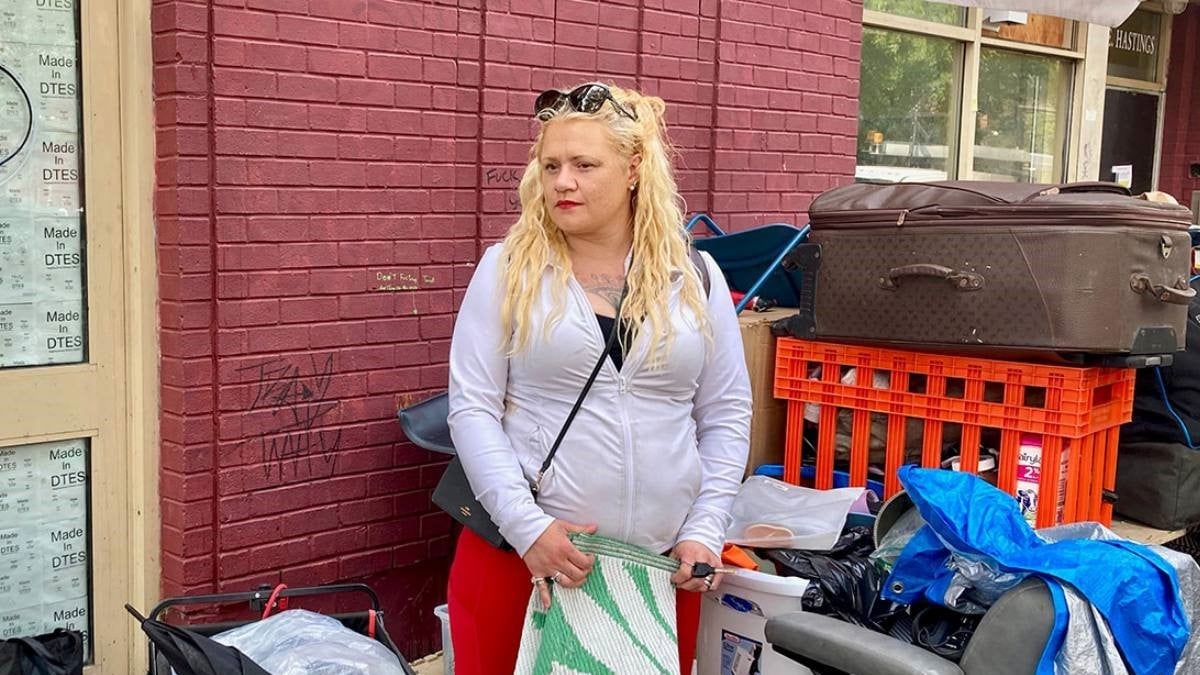When Dani Schroyen was evicted from Vancouver’s Hotel Canada in June, she ended up living in Cathedral Square, hoping to meet with outreach workers and get housing again. Then one night, all her belongings were set on fire.
“I walked away from there, devastated,” Schroyen said. When she spoke to The Tyee in early July, she was still hoping to meet with outreach workers and get another chance at being housed.
The Hotel Canada, an SRO in downtown Vancouver, is owned by the provincial government and operated as supportive housing by Atira Property Management.
It’s a type of housing that is supposed to help people stay housed, with on-site staffing and other supports available to prevent a return to homelessness.
But data from BC Housing shows that since 2020, 813 residents have been evicted from supportive housing and 285 of those tenants ended up in homeless shelters or back on the street. For 525 of those evicted tenants, it does not have information about where people ended up. BC Housing funds a total of 14,500 supportive housing units across the province.
BC Housing says it does not know how many of those evictions were from housing that falls under B.C.’s Residential Tenancy Act — which has specific regulations for how evictions are carried out — or transitional housing, which the act does not apply to. There are no rules around evictions from transitional housing, and it’s common for tenants to be unaware of which category their housing falls under.
Advocates who work with homeless people say Schroyen’s experience is common, and they believe BC Housing’s numbers are an undercount.
Karen Mills runs Peer2Peer Indigenous Society in Victoria and works as a housing navigator to help find housing for clients. Of the society’s 100 clients, Mills said, all of them have experienced being evicted from supportive housing. And 12 years ago, when Mills got a spot in supportive housing, she herself was evicted.
“I actually ran into a person that I housed seven months ago in supportive housing, and I was surprised to see him panhandling again on the street,” Mills said. “I asked him what happened and he told me, ‘I was kicked out.’”
Nicole Chaland, a housing researcher who studies homelessness and advocates for unhoused people, said it’s very common to hear that people have been evicted from supportive housing.
She welcomed BC Housing’s decision to release the data, but said the agency needs to regularly publish eviction numbers to help housing providers understand how to deliver effective programs to end homelessness.
She called for BC Housing to publish reports every month detailing the number of people who are new to homelessness, the number of people who are chronically homeless, the number who have returned to and exited homelessness, and the average length of time people are staying in shelters and transitional housing.
Chaland said evictions from supportive or transitional housing make it harder for all unhoused people to leave homelessness because the fear of losing their housing is always in the background, causing anxiety.
“One of the things that I learned is that it has a pretty big ripple effect on people on everyone else. Everybody has met someone that's been evicted from supportive housing or a transitional [housing] program,” Chaland said.
“Especially when you're talking about someone that's been homeless for 15 or 20 years, they don't believe that they're not going to be evicted.”
Housing providers say they do work with residents to try to change behaviour that can lead to an eviction, such as violence towards other residents or staff. Tenants commonly get written warnings about behaviour that could lead to an eviction, such as allowing entry to a former tenant who has been banned from the building.
Mills said common reasons for eviction include violence, non-compliance with policies, no mental health or recovery supports, violating policies on visitors, or conflicts with staff or other residents.
As the number of homeless people has grown in the province, the provincial government has announced more and more units of supportive housing. The model is supposed to help people who might have previously been evicted from rental housing because of mental health, addictions or other challenges.
A typical supportive housing building might have one or two staff on duty at a front desk, with tenant support workers meeting with residents from time to time. Some buildings have health-care facilities on site, and many offer meal programs.
In a statement, BC Housing said housing providers make every effort to keep people housed and evictions are “always a last resort and only made for legitimate reasons, like health and safety issues for the individual, other residents or staff in the building.”
BC Housing said that when evictions do happen, housing providers work with the tenant to find “other sheltering or housing options that meet their needs.”
The Crown corporation also said the province is investing in “complex care” buildings to provide housing for people with very high needs.
Mills said that when she got a spot in supportive housing over a decade ago, she had been homeless for several years. But none of the support staff at the building were Indigenous and she didn’t feel comfortable opening up about the traumatic experiences that had led her to become homeless.
Mills said she was evicted because she had not taken part in any of the programming at the building.
“By not participating, I was flagged as non-compliant and at-risk — hard to house,” Mills said.
After being evicted, Mills was homeless again. Finally, she was able to connect with an Indigenous outreach worker. With that worker’s help, Mills started to turn her life around: while she had attempted drug treatment programs before, this time she was successful. She was able to apply for disability benefits, get a rental apartment and regain care of her daughter. She’s lived in market rental housing ever since.
“In market rental housing I could do what I wanted. It was my place. I just had to be accountable to pay my rent. I didn’t have people coming into my house and doing random room inspections and going through my things,” Mills said.
“When I lived in supportive housing, they told me what time I had to eat and if I wasn’t hungry at that time or I missed it, that was it. I went without a meal.”
Mills said supportive housing workers should be better trained and have education in mental health and addiction. She also said it’s important to hire staff who have lived experience with homelessness or drug use.
“[When] I share that I used to be homeless and I used to do drugs and alcohol, the situation changes, because they know that I get it. I understand what they're saying,” Mills said.
Sometimes evictions do need to happen, Mills acknowledged, but said in those cases there should be a plan in place for alternative housing that is not a homeless shelter.
She also said it’s a problem that the tenants’ side of the story is rarely listened to; meanwhile, their file is passed from one provider to another, and can affect their ability to get housing in the future.
Chaland said governments are putting too much emphasis on supportive housing as the solution to homelessness, and called for a wider range of assistance that would include housing people in rental or social housing with rent supplements, with regular help from support workers if people need extra assistance.
Chaland said she has seen too many people believe they’re going to finally be housed after years of homelessness, but then don’t get the help they’re asking for.
“There are too many people who are not getting healthy and getting on with their lives. There's not, for example, a dedicated worker that would build trust with an individual,” Chaland said.
“It's intensive work. And it can't be the staff that work for the housing agency. They're never going to bridge the trust gap — because they have the power to evict people.” ![]()
Read more: Rights + Justice, Housing

















Tyee Commenting Guidelines
Comments that violate guidelines risk being deleted, and violations may result in a temporary or permanent user ban. Maintain the spirit of good conversation to stay in the discussion and be patient with moderators. Comments are reviewed regularly but not in real time.
Do:
Do not: